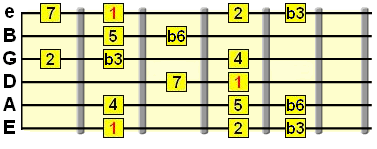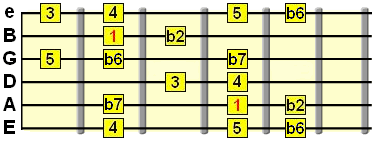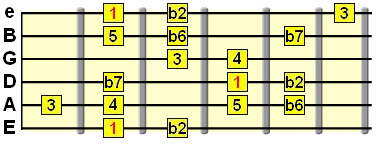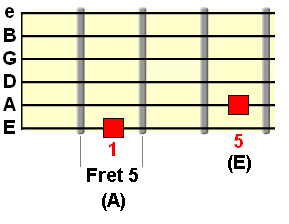Home
> Scales
>
Harmonic Minor/Phrygian
This lesson is about understanding the function of Phrygian dominant as a mode of the harmonic minor scale. If you're not quite sure what that means, it should be crystal clear by the end of this page.
Read every word. Take your time and experiment with what you learn. This is pretty in-depth stuff, but if you've prepared yourself through the lessons above, then you'll be fine and the rewards are significant.
First, we need to understand the relationship between the two scales - how and why are they related?
Note: The (b3) refers to a minor 3rd interval (the equivalent of one and a half steps) between the b6 and 7 of the scale.
That 1st degree note marks the root of the harmonic minor scale, so if the root note was C, the scale would be C harmonic minor. If it was the note F# (F sharp), the scale would be... yep, F# harmonic minor.

Now identify the 5th degree of the harmonic minor scale above. The 5th becomes the root note of a new scale, or more accurately, the 5th mode of that harmonic minor scale. That's where Phrygian dominant comes in...
Phrygian dominant is the 5th mode of harmonic minor because its root note lies on the 5th degree of the harmonic minor scale.
Play from that 5th tone, and you get the Phrygian sound, even though you're still playing through the same notes as the harmonic minor scale!
In the clip below, I play B harmonic minor from its root note, then from its 5th tone to show you this shift to the scale's 5th mode...
Click to hear
The sound changes because we've created a new tonal center around that 5th degree (sometimes labelled using Roman numerals - V) and are now using the notes of harmonic minor in a different context. 5 now becomes the root (1)...

This means if the bassist kept alternating between harmonic minor's root and the 5th, the boxed scale pattern above, overall, would be compatible with both positions.
When the 5th becomes the defined root note, it will sound like you're playing the Phrygian scale, even though you're still using the same harmonic minor pattern. Vice-versa for if you're playing the Phrygian scale and the bassist moves the root note to its 4th, since the 4 is in the same place as harmonic minor's 1 note!
Play the Phrygian scale
sequence below from the 4th
tone, and you get harmonic minor...

So what does all this mean in practical terms? It means if you want to play Phrygian dominant, you can simply play its parent harmonic minor scale. The table to the right shows you how the roots of harmonic minor and phrygian relate to one another...
In other words, you need to know where the 5th of harmonic minor is in relation to its root, not just in the above patterns, but wherever that root might appear on any string. Remember, the root-5th interval doesn't just appear in this scale, but also in other things you learn - power chords, major and minor arpeggios, other scales etc.
That was a hint to learn those relationships!
So, what happens when you use the root-5th relationship we learned above and build chords on those degrees rather than just play single notes?
Well, if we know we're playing harmonic minor in the key of A, for example, we should know that the 5th would lie on... E, based on our knowledge of where the 5th lies in relation to the root (1)!
5th fret
on the E string
= A
7th fret on the A string = E

Therefore, A minor / E major is one example of the 1 / 5 chord relationship, most often referenced using Roman numerals: i / V (lower case i for minor chord) The chord relationship is also called tonic / dominant.
Later we'll learn how using harmonic minor and phrygian dominant over their related chords naturally complements this movement.
Another example would be C minor / G major, since the note G would be the 5th of the C harmonic minor scale. The C root note of harmonic minor would become the root note for the i minor chord, the 5th note G would become the root note for the V major chord...

Click to hear
I'm just playing standard barre chords in that audio clip there, based on those two root note positions - a C minor barre chord and G major barre chord, based on those respective 1 / 5 root note positions.
So, remember - when you play a minor chord, know that if you want to get that Phrygian dominant tension, use the "V chord" by identifying the harmonic minor scale's 5th tone, and build a major chord from that note.
To enhance the V chord, a dominant 7th is commonly used, giving us V7.
Listen to the track below and hear how the dominant/5 chord of harmonic minor is used before the tonic D minor chord. There's also another chord in there, a minor sub-dominant chord built on harmonic minor's 4th degree.
D harmonic minor would work over that entire progression because the chords are part of that scale. Try it.
So the sequence goes: Dm (i) / Gm (iv) / A7 (V) / Dm (i)
Right click and "save as" to download
Using Phrygian dominant on that V major chord enhances that natural tension. Take a listen, and bear in mind I'm just playing the scale in straight sequence, so no flashy techniques here!
Click to hear
So there's a certain unresolved, unstable feel to that major V chord, which is then resolved by returning back to the tonic (i) minor chord. Over that tonic minor chord, the harmonic minor scale could be played to maintain some of that tension, but most commonly, musicians inter-change harmonic minor with the regular natural minor scale.
So, as we learned from before, the root of the V chord and its related Phrygian dominant mode, lies on the 5th of the i chord, and its related harmonic minor. But we can also see that, when the backing chord or bass is on the 5th degree of harmonic minor, the 7th becomes the 3rd of that V chord.
Why is this useful to know? Well, when you're emphasising that major 3rd on the V/Phrygian chord, you'll know that when the chord changes back to the tonic minor chord and you hold on to that 3rd, you'll be playing a major 7th over that tonic minor chord.
Now, that 7th of harmonic minor is often used as a leading tone. This means we don't hold on to it and tend to resolve it to the tone directly above it - in this case it would be the root of harmonic minor. However, if you shape the melody well, you can use that 7th as a tense landing note...
Click to hear (sounds pretty dark/sinister doesn't it?)
If you're struggling to grasp all this, don't worry, it just takes some experimentation to hear how chord sequences and harmonies naturally create tension and resolution, which you can enhance using the compatible scales/modes.
Below are a couple of jam tracks to help you experiment with your own ideas.
Thanks for your time and patience with all this!
Share your thoughts...
Have any questions, thoughts or ideas about this lesson? Let us know using the comments form below.
Harmonic Minor and Phrygian Dominant
In the harmonic minor and phrygian dominant lessons, we learned two separate scales and which chords/chord sequences they work well over. Hopefully you had a little play over the backing tracks provided in each lesson, to explore the unique flavours and tensions of each scale. Free
scale
pattern cheat sheet Free
scale
pattern cheat sheetEssential scale patterns that every guitarist must know... Click here to start now |
This lesson is about understanding the function of Phrygian dominant as a mode of the harmonic minor scale. If you're not quite sure what that means, it should be crystal clear by the end of this page.
Read every word. Take your time and experiment with what you learn. This is pretty in-depth stuff, but if you've prepared yourself through the lessons above, then you'll be fine and the rewards are significant.
First, we need to understand the relationship between the two scales - how and why are they related?
Phrygian Dominant as a Mode of Harmonic Minor
When looking at the degrees of harmonic minor, you can count them from note 1 to 7, before the sequence begins again. Tone number 1 marks the scale's 1st degree.1
W
2 H
b3 W 4
W
5 H b6
(b3)
7 H 1
Note: The (b3) refers to a minor 3rd interval (the equivalent of one and a half steps) between the b6 and 7 of the scale.
That 1st degree note marks the root of the harmonic minor scale, so if the root note was C, the scale would be C harmonic minor. If it was the note F# (F sharp), the scale would be... yep, F# harmonic minor.

Now identify the 5th degree of the harmonic minor scale above. The 5th becomes the root note of a new scale, or more accurately, the 5th mode of that harmonic minor scale. That's where Phrygian dominant comes in...
Phrygian dominant is the 5th mode of harmonic minor because its root note lies on the 5th degree of the harmonic minor scale.
Play from that 5th tone, and you get the Phrygian sound, even though you're still playing through the same notes as the harmonic minor scale!
In the clip below, I play B harmonic minor from its root note, then from its 5th tone to show you this shift to the scale's 5th mode...
Click to hear
The sound changes because we've created a new tonal center around that 5th degree (sometimes labelled using Roman numerals - V) and are now using the notes of harmonic minor in a different context. 5 now becomes the root (1)...

This means if the bassist kept alternating between harmonic minor's root and the 5th, the boxed scale pattern above, overall, would be compatible with both positions.
When the 5th becomes the defined root note, it will sound like you're playing the Phrygian scale, even though you're still using the same harmonic minor pattern. Vice-versa for if you're playing the Phrygian scale and the bassist moves the root note to its 4th, since the 4 is in the same place as harmonic minor's 1 note!
| Harmonic Minor Root | Phrygian Dominant Root |
| A | E |
| C | G |
| E | B |
| F# | C# |
| G | D |

So what does all this mean in practical terms? It means if you want to play Phrygian dominant, you can simply play its parent harmonic minor scale. The table to the right shows you how the roots of harmonic minor and phrygian relate to one another...
Root-5th fretboard relationships
When you've identified what key you're playing harmonic minor in, it's simply a case of knowing the fretboard and identifying how that relationship between the root and 5th (also known as a perfect 5th interval) appears in several locations across the fretboard.In other words, you need to know where the 5th of harmonic minor is in relation to its root, not just in the above patterns, but wherever that root might appear on any string. Remember, the root-5th interval doesn't just appear in this scale, but also in other things you learn - power chords, major and minor arpeggios, other scales etc.
That was a hint to learn those relationships!
Harmonic Minor/Phrygian Chords
We learned in the individual scale lessons that, simply put, harmonic minor builds minor chords and Phrygian dominant builds major chords. These two chords play off each other because they're part of that same harmonic minor scale, just using a different degree of that scale.So, what happens when you use the root-5th relationship we learned above and build chords on those degrees rather than just play single notes?
Well, if we know we're playing harmonic minor in the key of A, for example, we should know that the 5th would lie on... E, based on our knowledge of where the 5th lies in relation to the root (1)!
| Parent Scale | Tonic (i) | Dominant (V) | Audio |
| A Harmonic Minor | Am |
Emaj or E7 |
Click here |
| C Harmonic Minor | Cm |
Gmaj or G7 |
Click here |
| E Harmonic Minor | Em |
Bmaj or B7 |
Click here |
| F# Harmonic Minor | F#m |
C#maj or C#7 |
Click here |
7th fret on the A string = E

Therefore, A minor / E major is one example of the 1 / 5 chord relationship, most often referenced using Roman numerals: i / V (lower case i for minor chord) The chord relationship is also called tonic / dominant.
Later we'll learn how using harmonic minor and phrygian dominant over their related chords naturally complements this movement.
Another example would be C minor / G major, since the note G would be the 5th of the C harmonic minor scale. The C root note of harmonic minor would become the root note for the i minor chord, the 5th note G would become the root note for the V major chord...

Click to hear
I'm just playing standard barre chords in that audio clip there, based on those two root note positions - a C minor barre chord and G major barre chord, based on those respective 1 / 5 root note positions.
So, remember - when you play a minor chord, know that if you want to get that Phrygian dominant tension, use the "V chord" by identifying the harmonic minor scale's 5th tone, and build a major chord from that note.
To enhance the V chord, a dominant 7th is commonly used, giving us V7.
Listen to the track below and hear how the dominant/5 chord of harmonic minor is used before the tonic D minor chord. There's also another chord in there, a minor sub-dominant chord built on harmonic minor's 4th degree.
D harmonic minor would work over that entire progression because the chords are part of that scale. Try it.
So the sequence goes: Dm (i) / Gm (iv) / A7 (V) / Dm (i)
Right click and "save as" to download
The Harmonic Function of Phrygian Dominant
As we touched on in both the individual scale lessons, there is a certain tension created between harmonic minor and its 5 chord (which, as we learned above, Phrygian dominant is built around).Using Phrygian dominant on that V major chord enhances that natural tension. Take a listen, and bear in mind I'm just playing the scale in straight sequence, so no flashy techniques here!
Click to hear
So there's a certain unresolved, unstable feel to that major V chord, which is then resolved by returning back to the tonic (i) minor chord. Over that tonic minor chord, the harmonic minor scale could be played to maintain some of that tension, but most commonly, musicians inter-change harmonic minor with the regular natural minor scale.
Using the 3rd of Phrygian dominant as a leading tone
When that V chord resolves to the minor tonic chord of the same key, the 3rd tone of Phrygian becomes the 7th of harmonic minor...| Harm Min (i) | 1 | 2 | b3 | 4 | 5 | b6 | 7 |
| Phryg Dom (V) | 4 | 5 | b6 | b7 | 1 | b2 | 3 |
So, as we learned from before, the root of the V chord and its related Phrygian dominant mode, lies on the 5th of the i chord, and its related harmonic minor. But we can also see that, when the backing chord or bass is on the 5th degree of harmonic minor, the 7th becomes the 3rd of that V chord.
Why is this useful to know? Well, when you're emphasising that major 3rd on the V/Phrygian chord, you'll know that when the chord changes back to the tonic minor chord and you hold on to that 3rd, you'll be playing a major 7th over that tonic minor chord.
Now, that 7th of harmonic minor is often used as a leading tone. This means we don't hold on to it and tend to resolve it to the tone directly above it - in this case it would be the root of harmonic minor. However, if you shape the melody well, you can use that 7th as a tense landing note...
Click to hear (sounds pretty dark/sinister doesn't it?)
If you're struggling to grasp all this, don't worry, it just takes some experimentation to hear how chord sequences and harmonies naturally create tension and resolution, which you can enhance using the compatible scales/modes.
Below are a couple of jam tracks to help you experiment with your own ideas.
Thanks for your time and patience with all this!
| Backing Track | Tonic (I) chord/scale | Dominant (V) chord/scale |
| Download | D minor/D harmonic minor | A major/A Phrygian dominant |
| Download | B minor/B harmonic minor | F# major/F# Phrygian dominant |
| Was this
helpful? Please support this site. I really appreciate it! |
Stay updated
and learn more Sign up to the newsletter for updates and grab your free Uncommon Chords book |
Share your thoughts...
Have any questions, thoughts or ideas about this lesson? Let us know using the comments form below.








